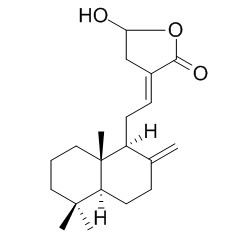Coronarin D
Coronarin D shows promising antifungal activity against C. albicans in vitro, the minimum inhibitory concentration (MIC) and the minimum fungicidal concentration (MFC) were 2 and 4 mg/mL, respectively; it is active against tested Gram-positive bacteria, inactive for tested Gram-negative bacteria, and weakly active against tested fungi; using coronarin D-antibiotic drug combination can combat the infectious diseases.Coronarin D inhibits NF-kappaB activation pathway, which leads to inhibition of inflammation, invasion, and osteoclastogenesis, as well as potentiation of apoptosis.
Inquire / Order:
manager@chemfaces.com
Technical Inquiries:
service@chemfaces.com
Tel:
+86-27-84237783
Fax:
+86-27-84254680
Address:
1 Building, No. 83, CheCheng Rd., Wuhan Economic and Technological Development Zone, Wuhan, Hubei 430056, PRC
Providing storage is as stated on the product vial and the vial is kept tightly sealed, the product can be stored for up to
24 months(2-8C).
Wherever possible, you should prepare and use solutions on the same day. However, if you need to make up stock solutions in advance, we recommend that you store the solution as aliquots in tightly sealed vials at -20C. Generally, these will be useable for up to two weeks. Before use, and prior to opening the vial we recommend that you allow your product to equilibrate to room temperature for at least 1 hour.
Need more advice on solubility, usage and handling? Please email to: service@chemfaces.com
The packaging of the product may have turned upside down during transportation, resulting in the natural compounds adhering to the neck or cap of the vial. take the vial out of its packaging and gently shake to let the compounds fall to the bottom of the vial. for liquid products, centrifuge at 200-500 RPM to gather the liquid at the bottom of the vial. try to avoid loss or contamination during handling.
Aquaculture2019, 510:392-399
J Ethnopharmacol.2017, 206:327-336
Horticulture Research2022, uhac276.
Foods.2022, 11(12):1773.
Eur J Pharmacol.2024, 963:176280.
Int. J. Mol. Sci.2022, 23(8), 4130.
Pathol Res Pract.2024, :260:155445.
Molecules.2020, 25(18),4089.
Phytother Res.2018, 32(5):923-932
Molecules.2024, 29(24):5983.
Related and Featured Products
Biomed Res Int. 2014;2014:581985.
Antimicrobial activity of coronarin D and its synergistic potential with antibiotics.[Pubmed:
24949458]
Coronarin D is a labdane-type diterpene from the rhizomes of Hedychium coronarium. In the view of our ongoing effort to explore its novel biological activity, antimicrobial activity study of Coronarin D was performed.
METHODS AND RESULTS:
The results showed that Coronarin D was active against tested Gram-positive bacteria, inactive for tested Gram-negative bacteria, and weakly active against tested fungi. The antibacterial effect of the combination of Coronarin D with nine classical antibiotics against four Gram-positive bacteria was also evaluated. The fractional inhibitory concentration indices (FICI) of Coronarin D-antibiotics combinations, calculated from the checkerboard assay, were used as synergism indicator. Out of 36 combinations, 47% showed total synergism, 33% had partial synergistic interaction, 17% showed no effect, and 3% showed antagonism. By combination with Coronarin D at concentration of 0.25 minimal inhibitory concentration (MIC), the activities of antibiotics were boosted to 4- to 128-fold.
CONCLUSIONS:
These finding suggested an attractive approach to combat the infectious diseases by using Coronarin D-antibiotic drug combination.
Oral Surg Oral Med Oral Pathol Oral Radiol. 2012 Jul;114(1):61-6.
Antifungal activity of coronarin D against Candida albicans.[Pubmed:
22727093]
The objective of this study was to investigate the antifungal activity of Coronarin D on Candida albicans and its activity was compared with clotrimazole and nystatin.
METHODS AND RESULTS:
Coronarin D was extracted by liquid chromatography and used in antifungal testing. The inhibitory effect of Coronarin D on C. albicans was determined by cultures and an applied broth dilution test. The rate of fungicidal activity was evaluated by time-kill curves. Morphologic alterations of fungal cells were investigated using scanning electron microscopy. Coronarin D was effective against C. albicans; the minimum inhibitory concentration (MIC) and the minimum fungicidal concentration (MFC) were 2 and 4 mg/mL, respectively. The C. albicans killing activity of Coronarin D was higher than clotrimazole and nystatin at 2 × MFC and 4 × MFC, respectively. Morphologic alterations of fungal cells consistent with cell membrane damage were observed in the Coronarin D-treated cells.
CONCLUSIONS:
Coronarin D showed promising antifungal activity against C. albicans in vitro.
Mol Cancer Ther. 2008 Oct;7(10):3306-17.
Coronarin D, a labdane diterpene, inhibits both constitutive and inducible nuclear factor-kappa B pathway activation, leading to potentiation of apoptosis, inhibition of invasion, and suppression of osteoclastogenesis.[Pubmed:
18852134]
METHODS AND RESULTS:
We investigated the effect of Coronarin D on NF-kappaB activation pathway, NF-kappaB-regulated gene products, and NF-kappaB-regulated cellular responses. The Coronarin D inhibited NF-kappaB activation induced by different inflammatory stimuli and carcinogens.Coronarin D also inhibited the NF-kappaB-regulated gene products involved in cell survival (inhibitor of apoptosis protein 1, Bcl-2, survivin, and tumor necrosis factor receptor-associated factor-2), proliferation (c-myc, cyclin D1, and cyclooxygenase-2), invasion (matrix metalloproteinase-9), and angiogenesis (vascular endothelial growth factor).Coronarin D was found to be more potent than its analogue Coronarin D acid.
CONCLUSIONS:
Overall, our results show that Coronarin D inhibited NF-kappaB activation pathway, which leads to inhibition of inflammation, invasion, and osteoclastogenesis, as well as potentiation of apoptosis.
Bioorg Med Chem Lett. 2011 Dec 15;21(24):7460-5.
Chemical constituents of the rhizomes of Hedychium coronarium and their inhibitory effect on the pro-inflammatory cytokines production LPS-stimulated in bone marrow-derived dendritic cells.[Pubmed:
22071304]
METHODS AND RESULTS:
The rhizomes of Hedychium coronarium have been used for the treatment of inflammation, skin diseases, headache, and sharp pain due to rheumatism in traditional medicine. From this plant, three new labdane-type diterpenes 1-3, named coronarins G-I as well as seven known 4-10, Coronarin D, Coronarin D methyl ether, hedyforrestin C, (E)-nerolidol, β-sitosterol, daucosterol, and stigmasterol were isolated.



